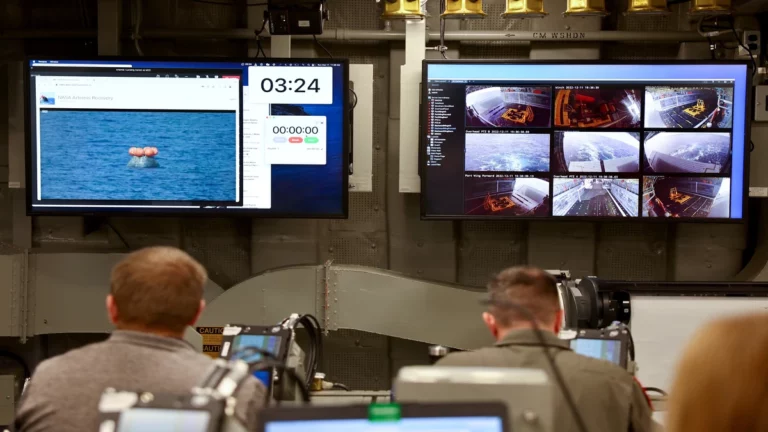NASA’s Orion spacecraft flew over the Moon’s far side and released the closest pictures of the Moon, coming nearly 81 miles from the surface. Since Wednesday, when it was released as part of the Artemis I mission, the spacecraft, which is unmanned, has been heading toward the Moon. It will travel for another 20 days. At a media briefing on Monday evening, NASA’s Orion program manager Howard Hu stated that the spacecraft is still performing admirably.
What is the Goal behind this Trip?
- One of the mission’s main objectives is to ensure that the Orion capsule spacecraft functions as intended and give moon picture. NASA has the chance to make any necessary improvements and upgrades before astronauts aboard the Artemis II mission, which isn’t scheduled to launch until at least 2024. On the third Artemis mission, which will use an Orion spacecraft and a SpaceX vehicle, astronauts will try to land on the Moon.
- NASA’s Artemis program, which intends to return individuals to the Moon and help them prepare for a future trip to Mars, was launched with Orion’s launch, carrying a mannequin crew to represent a real crew.
- Jim Geffre, NASA’s Orion vehicle integration manager, stated they would examine how the heat soaks back into the command module and how it impacts the climate inside.
- State of the spacecraft following the flight, data from sensors monitoring velocity and vibration, and the effectiveness of a special vest worn by a mannequin inside the spacecraft to test how to protect individuals from radiation while in space are among the additional pieces of data that will be gathered. A crewed Artemis II voyage all around the lunar surface and back might happen as early as 2024, although still without landing on it if the mission is successful.
- Onboard NASA’s Space Launch System (SLS) rocket which is more explosive than the Saturn V used during the Apollo era, Orion blasts out from Kennedy Space Center in Florida.
- The European Service Module (ESM), which provides water, air, electricity, and propulsion, is connected to the cylindrical Orion crew module from launching until just before re-entry.
- The European Space Agency provides the ESM for Orion missions, which is 4.5m broad and 3m long (ESA). From the main body, four 7m-long solar arrays project outward. To follow the Sun, they tilt and revolve, producing sufficient electricity to run two three-bedroom homes.
- NASA is expected to announce soon the astronauts selected for this mission. The first spacecraft will touch down on the south pole of the Lunar during Artemis III in 2025, where water exists in the form of ice.
Close Encounter between NASA Craft and the Moon Ends
As per NASA, Orion’s flight has been going well thus far. On Monday, the NASA spacecraft fired up its engine 2.5 minutes before approaching the Moon and taking the closest pictures of the Moon. It caused it to accelerate as it swung outward into a distant retrograde orbit.
The spacecraft is in an orbital inclination, which means it circles the Moon in the reverse direction from how it orbits the Earth and is 40,000 miles above the lunar surface. Halfway through its 25-day mission, the spacecraft traveled 432,210km (268,563 miles) from Earth, reaching its highest point in orbit. That surpasses the milestone of 32,187km (20,000 miles), set in 1970 by the astronauts of Apollo 13, who abandoned their landing on the Moon and returned to Earth due to an almost catastrophic mechanical breakdown. On Monday, the Orion spacecraft made the closest approach to the Moon since Apollo 17’s flight fifty years ago, sailing within 130 km (80 miles) of the lunar surface. However, the primary test of Orion’s heat shield, the largest ever constructed, won’t come at the very last moments of the mission. The spacecraft must endure a 2,800 degrees Celsius temperature, which is probably half that of the solar surface, as it hurtles through the Earth’s atmosphere at a velocity of 40,000 kph.
After the capsule’s initial test in 2014, it continued to orbit the Earth and returned to Upper orbit at a reduced speed of roughly 32,187 kph. Despite a few funny stuff, the Artemis I mission went smoothly without a hitch, according to Mike Sarafin, the mission manager. Orion’s star trackers briefly became confused as the spacecraft’s engines fired was among the funniest scenes. Spacecraft astronauts and passengers are both meant to be protected by it. Therefore, the heat shield must function, he stated. To collect the Orion spacecraft, NASA has sent the USS Portland of the US Navy, along with helicopters and inflatable boats.
Six days will pass while the spacecraft is there, allowing mission commanders enough time to test Orion’s systems. According to NASA missions, it would be the distance from Earth that a spacecraft built to carry people had ever traveled.
Previously, the record was set when Apollo 13’s damaged spacecraft could not enter orbit and was forced to swing around lunar to return to Earth.
Detailed Description of Closest Pictures of the Moon
- A camera on Orion captured moon image, or the small blue marble of Earth slipping behind the massive grey disc of the Moon in the front, before the flyby, which showed the Moon growing larger and larger as the spacecraft neared.
- As the spacecraft passed behind the Moon, NASA’s mission controllers lost contact with it. Therefore, they were unaware that the engine activation had been quite successful till Orion reappeared after 34 minutes.
- According to NASA mission director Judd Frieling, the spacecraft demonstrated its ability to transmit live imagery back to Earth during the flyby. It vowed to broadcast more information on a NASA website when it was practicable. The Orion took Artemis picturesand videos of the Moon’s far side without connection behind the lunar. They’ll need a few days to finish those specific photographs, Frieling said.
- One of the moon pictures NASA display the “radargram” that MARSIS captured during the flyby of Phobos on September 23, 2022. The “echoes” produced when a MARSIS radio signal reflects off anything and rebounds to the equipment are seen on a radargram. With increasing signal brightness, echo strength increases.
- The uninterrupted brilliant line depicts the echo from the Moon’s surface. The lower echoes are either “clutter” brought on by the Moon’s surface characteristics or, more intriguingly, could result from structural structures present under the surface.
More info on this Mission
- Artemis I was released by NASA’s generated enormous Space Launch System rocket from the Florida-based Kennedy Space Center.
- NASA will let Orion float in the water for just 2 hours, longer than it would in case of astronauts were inside, to gather data for upcoming missions.
- However, Artemis’ major non-American element was in use during the flyby. The components of the Space Launch rocket were developed by Northrop Grumman, Boeing, and the United Launch Alliance, whereas Lockheed Martin produced the Orion spacecraft.
- The business module was developed by Airbus and was one of the efforts undertaken for the Artemis program by the European Space Agency. The launch system is the section of Orion far below the capsule and includes thrusters, telecommunication technologies, solar panels, and other supplies. Before the capsule splashes down, the module will be released and explode in the atmosphere rather than returning to Earth.
- As Orion is launched into the far-off retrograde orbit on Friday, the service component’s engines will fire again. Following Monday, Orion will have traveled over 270,000 miles from Earth, surpassing the previous record set by Apollo 13 on Saturday of 248,655 miles for an astronaut-carrying spacecraft.
- A shakeout voyage for the SLS, Orion, and their related ground systems is Artemis 1. NASA may start preparing for Artemis 2, which would take men around the Moon in 2024 if everything goes according to plan on Sunday.
- Artemis 3 will set foot near the Moon’s South Pole in 2025 or 2026. A research facility will be established in that area, which is anticipated to be rich in water ice, by upcoming flights in NASA’s Artemis program. By the end of the 2030s or the beginning of the 2040s, NASA intends to send astronauts to Mars using the expertise learned from these lunar missions.
With the closest pictures of the Moon, NASA is looking forward to building a high-end that will be on the Moon’s surface. It will orbit space station to create a permanent human presence there. In the late 2030s, if people learn to live on the Moon, engineers may be able to develop technologies for a lengthy trip to Mars.

















